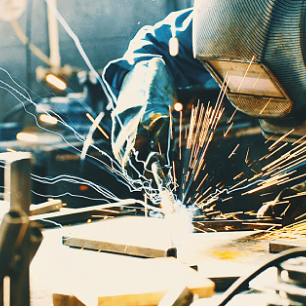Jump to:
Handheld Laser Welding Safety
Handheld laser welding equipment is a high-power Class 4 laser instrument.
All persons using welding processes should already be aware of the necessary precautions, such as electrical, fumes and gases, fire or explosion, burn, arc rays, noise, and electric and magnetic fields (EMF). In addition to the above-listed arc welding hazards, users should understand that handheld laser welding equipment creates laser beam hazards.
In addition to the hazards associated with arc welding, direct, or reflected high-power laser beams are hazardous to view under any condition. In the U.S., handheld laser standards exist regarding the general safe use of lasers and the safe use of lasers in manufacturing environments (e.g., ANSI Z136.1 and ANSI Z136.9). High-power lasers typically emit multiple kilowatts of high-intensity visible or invisible (near-infrared) light.
Each organization or any sole operator outside an organization operating Class 3B or 4 lasers shall:
- Appoint a qualified Laser Safety Officer (LSO) or be trained as such.
- Have a documented Laser Safety Program.
- Have a Laser Controlled Area (LCA) for each point of use (see “How to Reduce Exposure” section for specific LCA requirements).
Operators and all persons in the LCA shall wear specified personal protective equipment (PPE), laser safety eyewear, including laser welding helmet, heat-resistant gloves, and flame-resistant clothing.
Nature of the Hazards
Class 4 high-power lasers present the most serious of all laser hazards.
The reflected beam hazard typically occurs momentarily before the laser-induced plasma initiates (emitting light similar to that from an arc). A hazardous laser beam reflected
forward of the torch can exist for a longer time period if the plasma is not immediately initiated. Precautions shall be taken to prevent incidental exposure to both direct and reflected beams.
Specular (mirror-like) laser beam reflections can inflict instantaneous and permanent severe eye and skin damage.
Eye Hazards
Exposure to laser light can inflict severe retina and/or cornea injuries, leading to permanent eye damage. Some laser light, including the welding, cutting, or cleaning beam (e.g. 1070 nm), is invisible. Laser safety eyewear is designed to protect against direct, reflected, scattered laser beams and radiation. Follow the equipment manufacturer’s recommendations for the appropriate wavelength and optical density (OD) of protective eyewear. Always inspect eyewear for damage or improper fit before use. Direct beams are the most hazardous. Depending on the power level of the laser beam, laser safety eyewear is designed only to protect from incidental (i.e., very brief) direct and reflected beams. Never look directly into a laser aperture, even if wearing full eye protection. Never point the torch at another person.
In addition to laser safety eyewear, the user shall wear a laser welding helmet. It is important to understand that standard safety eyewear and standard welding helmets do not provide adequate protection from laser beam hazards.
Skin Hazards
Exposure to infrared (IR) and ultraviolet (UV) light radiation, as well as heat and sparks, can cause injury to the skin. All persons in the LCA shall wear all appropriate PPE. Exposure to UV light and from the plasma (the bright light created during welding) can cause sunburn and increase a user’s risk of skin cancer and accelerated signs of skin aging.
Reflection Hazards
Highly reflective metals can produce hazardous reflected beams by “specular” (mirror-like) — Fig. 1. The intensity of the reflection will vary based on the material type and surface finish. Also, very thermally conductive metals (e.g., aluminum and copper) can cause some portion of the laser beam energy to be reflected from the target weld site since the plasma ignition is delayed (Fig. 1). Once the plasma is initiated, specular reflection is minimized. The user needs to assess the work site prior to using the hand-held laser welding equipment to understand the surfaces where hazardous reflected beams can exist. This assessment shall include a complete review of the LCA.
The normal direction of the laser reflection from a metal surface can produce a hazardous beam reflected from one surface of the targeted weld site — Fig. 2, Detail A.
Additionally, the normal direction of the laser reflection can produce a hazardous beam reflected back from two surfaces oriented at an angle (termed a “retroreflection”) — Fig. 2, Detail B.
Specular reflections can present eye and skin hazards to the operator as a portion of the beam can be reflected from multiple surfaces.
How to Reduce Exposure
Handheld Laser Welding Equipment
Read and follow all labels and the equipment Owner’s Manual before installing, operating, or servicing handheld laser welding equipment. Follow all standards, individual facility or building regulations, and national, state, and local codes.
Have only qualified persons install, operate, maintain, and repair handheld laser welding equipment.
Users shall ensure handheld laser welding equipment incorporates important built-in safety features required for all Class 4 laser products as follows:
- Key switch to secure the equipment and control unauthorized operation.
- Emergency stop button to terminate laser emission immediately.
- Connection for an external interlock to shut down the laser if someone other than the operator unexpectedly enters the LCA.
Users of handheld laser equipment should consider additional safety features as required in ISO 11553-1, an international safety standard for handheld lasers, to protect operators and bystanders, including the following:
- Two-stage trigger on the torch to help prevent unintentional laser emission.
- Plasma Detection — the handheld torch includes a photo sensor to monitor plasma. If there is not sufficient plasma light created after the start of a weld, the equipment will automatically turn laser emission off.
- Workpiece contact circuit to make sure the laser can only be enabled when the torch tip is in contact with the part being welded.
- Optical interlock circuit in the fiber optic cable set to verify the integrity of the connection between the welding torch and the laser power supply.
Laser Controlled Area
Provide an LCA for each point of use, including demonstrations. An LCA is a light-tight enclosure with laser-blocking panels, an access door with an interlock switch, and a “Laser On” warning sign. Any barriers or windows used in the welding area shall be made of a laser-safe material that can withstand direct and reflected beams.
Appropriate laser warning signs shall be posted throughout the controlled area, especially any entrances to and from the area.
Restrict access to the LCA only to those individuals who are trained in laser safety while operating a laser.
See OSHA, Technical Manual (OTM), Section III: Chapter 6, Laser Hazards (osha.gov).
Laser Safety Officer
Each organization shall have a qualified LSO who is responsible for the safety of operators and observers, which includes but is not limited to:
- Conducting a hazard evaluation of all beam and nonbeam hazards
- Ensuring that all control measures are implemented and followed
- Approving operating procedures related to the use of lasers
- Ensuring that every operator and observer who uses lasers or is exposed to laser hazards has information and training on the safe use of the equipment and potential hazards.
Information Sources
1. American Conference of Governmental Industrial Hygienists (ACGIH). TLVs and BEIs: Based on the Documentation of the Threshold Limit Values for Chemical Substances and Physical Agents & Biological Exposure Indices. (acgih.org).
2. American Welding Society. ANSI Z49.1, Safety in Welding, Cutting, and Allied Processes. (aws.org).
3. American National Standards Institute. ANSI Z87.1, Safe Practice for Occupational and Educational Eye and Face Protection. (ansi.org).
4. American National Standards Institute. ANSI Z136.1, Safe Use of Lasers. (ansi.org).
5. American National Standards Institute. ANSI Z136.9, Safe Use of Lasers in Manufacturing Environments. (ansi.org).
6. Canadian Standards Association. CSA W117.2, Safety in Welding, Cutting, and Allied Processes. (csagroup.org).
7. Henrichsen, M., Schwarz, B., Ritt, G., Azarian, A., and Eberle, B. 2021. Laser safety assessments supported by analyses of reflections from metallic targets irradiated by high-power laser light. Applied Optics 60(22): F71–F87.
8. International Electrotechnical Commission. IEC 60825-1, Safety of laser products – Part 1: Equipment classification and requirements. (webstore.iec.ch/publication/3587).
9. International Organization for Standardization. ISO 11553-1, Safety of machinery — Laser processing machines. Part 1: Laser safety requirements (iso.org/standard/67658.html).
10. International Organization for Standardization. ISO 11553-2, Safety of machinery — Laser processing machines. Part 2: Laser safety requirements for hand-held or hand-operated laser processing machines. (iso.org/standard/67658.html).
11. Laser Institute of America. Questions that an OSHA Inspector May Ask You about Laser Safety Fact Sheet. (assets.lia.org/s3fs-public/pdf/OSHAquestions_2018.pdf).
12. National Fire Protection Association. NFPA 51B, Standard for Fire Prevention During Welding, Cutting, and Other Hot Work. (nfpa.org/codes-and-standards/nfpa-51b-standard-development/51b).
13. Occupational Safety and Health Administration. OSHA 1910.177 Title 29, Subpart N, Part 1910 Subpart Q, and Part 1926, Subpart J, Occupational Safety and Health Standards for General Industry, Occupational Safety and Health Administration, Code of Federal Regulations (CFR). (osha.gov).
14. Occupational Safety and Health Administration. OSHA 1040.10 Title 21 Code of Federal Regulations (CFR) Chapter I, Subchapter J, Laser Products, Occupational Safety and Health Standards for Food and Drugs, Occupational Safety and Health Administration, Code of Federal Regulations (CFR). (osha.gov).
15. Occupational Safety and Health Administration. OSHA, Technical Manual (OTM), Section III: Chapter 6, Laser Hazards. (osha.gov).
American Welding Society Fact Sheet No. 46 may be downloaded at (aws.org/standards-and-publications/free-resources). AWS disclaims liability for any injury to persons or to property, or other damages of any nature whatsoever, whether special, indirect, consequential or compensatory, directly or indirectly resulting from the publication, use of, or reliance on this information. AWS also makes no guaranty or warranty as to the accuracy or completeness of any information published herein.


